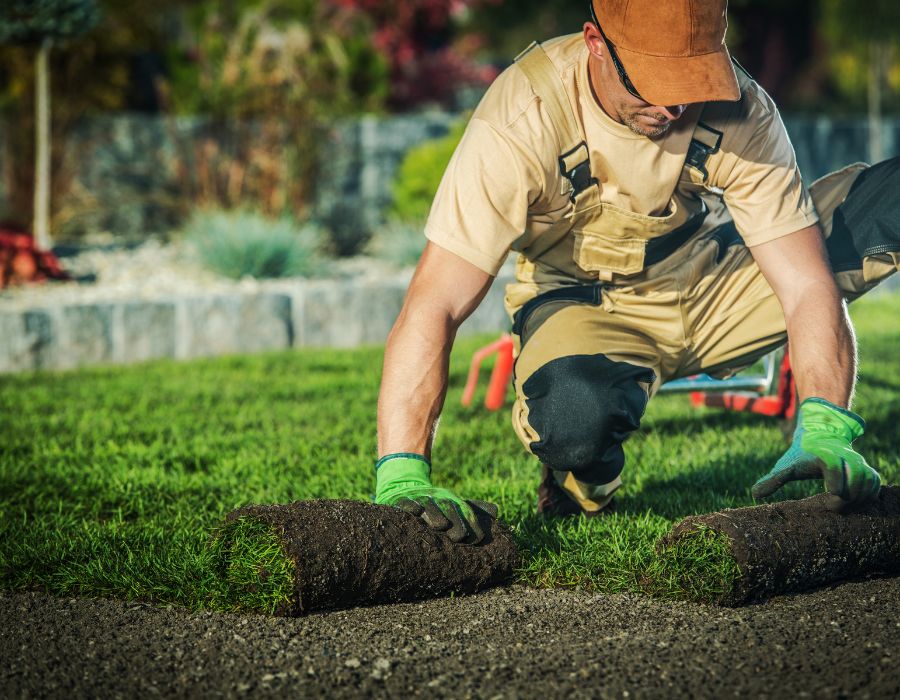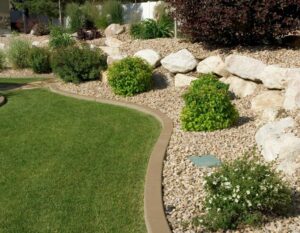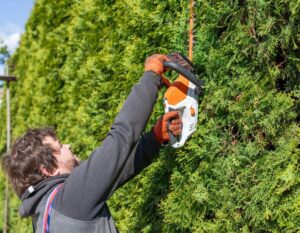Curb appeal plays a crucial role in making a lasting first impression, and hardscaping is an excellent way to elevate your home’s exterior. By integrating functional and decorative hardscaping elements, such as patios, walkways, retaining walls, and landscaping you can enhance both the aesthetics and usability of your outdoor space. We’ll explore the importance of hardscaping, material choices, project ideas, and how to seamlessly blend hardscape features with natural landscaping elements.
Understanding Hardscaping
Hardscaping refers to the non-living elements of landscaping, including structures, pathways, and decorative features made from stone, brick, concrete, or wood. Unlike softscaping, which involves plants, trees, and flowers, hardscaping focuses on adding durability, structure, and function to outdoor spaces.
Key Benefits of Hardscaping:
- Low Maintenance: Hardscaping elements require less upkeep compared to lawns and gardens.
- Enhanced Curb Appeal: Properly designed hardscapes create a polished and inviting exterior.
- Increased Property Value: High-quality hardscaping features can boost the resale value of your home.
- Improved Outdoor Functionality: Patios, walkways, and retaining walls make your yard more accessible and usable.
Popular Hardscaping Elements to Elevate Your Outdoor Space
1. Patios and Walkways
Patios and walkways serve as the foundation of an inviting and well-structured landscape. They create designated areas for relaxation, entertainment, and movement throughout your yard.
Best Materials for Patios and Walkways:
- Paver Stones: Durable and customizable, available in various colors and patterns.
- Natural Stone: Offers a timeless and elegant look but can be more expensive.
- Decorative Concrete: Affordable and versatile, mimicking natural stone or brick.
- Brick: A classic choice that adds warmth and character to any outdoor space.
Design Tips:
- Opt for curved walkways for a more natural and organic feel.
- Use contrasting materials or edging to define pathways clearly.
- Incorporate lighting along walkways to enhance safety and ambiance.
2. Retaining Walls
Retaining walls are both functional and decorative, helping to prevent soil erosion while adding visual interest to a landscape. They are commonly used to create tiered gardens, define outdoor spaces, and support sloped yards.
Best Materials for Retaining Walls:
- Concrete Blocks: Cost-effective and highly durable.
- Natural Stone: Offers a rustic, high-end appearance.
- Brick: Provides a traditional and sturdy aesthetic.
- Timber: Ideal for rustic or cottage-style landscapes but requires proper treatment to prevent rot.
Design Tips:
- Combine different materials for a layered and dynamic look.
- Use retaining walls to create built-in seating areas for functional yard features.
- Incorporate greenery by adding plants or vines to soften the structure.
3. Outdoor Living Spaces
An outdoor living space can transform your backyard into a functional extension of your home, perfect for entertaining and relaxation.
Popular Hardscape Features for Outdoor Living:
- Fire Pits: A focal point for social gatherings, available in gas or wood-burning options.
- Pergolas: Provide shade while adding an architectural element to your yard.
- Built-In Seating: Permanent stone or concrete benches enhance usability and aesthetics.
- Outdoor Kitchens: Equipped with grills, sinks, and countertops for alfresco dining.
Design Tips:
- Use matching materials across different hardscaping elements for a cohesive look.
- Position seating areas near gardens or water features to enhance relaxation.
- Incorporate weather-resistant furniture and accessories for longevity.
4. Landscaping Structures
Adding landscaping structures can further define and enhance your outdoor space. These elements serve both decorative and functional purposes.
Popular Structures:
- Arbors and Trellises: Ideal for supporting climbing plants and adding height to your garden.
- Fountains and Water Features: Bring movement and tranquility to a yard.
- Garden Borders and Edging: Define flower beds and separate different landscaping zones.
- Stone Pathways: Offer charming and practical access points throughout your garden.
Design Tips:
- Choose materials that complement your home’s architecture.
- Integrate lighting to highlight structures at night.
- Pair structures with greenery to maintain a natural, balanced look.
FAQs About Hardscaping
What’s the difference between hardscaping and traditional landscaping?
Hardscaping refers to the non-living, structural elements of an outdoor space, such as patios, pathways, retaining walls, and stone features. Traditional landscaping (or softscaping) involves living components like grass, plants, shrubs, and trees. A well-balanced yard often combines both for optimal aesthetics and functionality.
Which materials are most durable for patios and walkways?
Durable materials for patios and walkways include paver stones, concrete, brick, and natural stone. Paver stones and decorative concrete offer high durability and flexibility, while natural stone provides a sophisticated, long-lasting option.
Do I need permits for certain hardscaping projects?
Permit requirements vary based on location and project scope. Typically, permits are required for large-scale hardscaping features such as:
- Retaining walls over a certain height (often above 4 feet).
- Outdoor kitchens with plumbing or gas lines.
- Patios and driveways that affect drainage or property lines.
Check with your local building department before starting a hardscaping project to ensure compliance with zoning laws and regulations.
How do I blend hardscape features with my existing greenery?
Blending hardscape features with greenery creates a harmonious and visually appealing landscape. Here’s how:
- Incorporate softscaping around hardscape elements: Surround patios with flower beds or use vines to soften walls.
- Choose complementary colors and textures: Select materials that contrast yet harmonize with the natural surroundings.
- Add planter boxes and vertical gardens: These can help integrate greenery into stone or concrete spaces.
- Use curved lines and organic shapes: This helps hardscape elements blend naturally with the landscape design.
Conclusion
Hardscaping is a powerful tool for enhancing curb appeal and adding functional beauty to your outdoor space. Whether you’re installing patios and walkways, retaining walls, or outdoor living features, selecting the right materials and designs will help create a lasting impression. By blending hardscape elements with lush greenery, your landscape will achieve a perfect balance of durability and natural charm, increasing both your home’s aesthetic value and usability.





